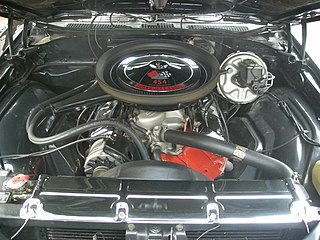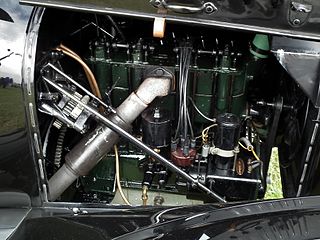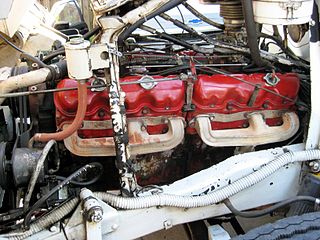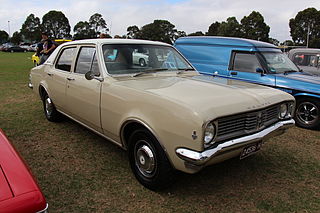
Pontiac was an American automobile brand owned, manufactured, and commercialized by General Motors. Introduced as a companion make for GM's more expensive line of Oakland automobiles, Pontiac overtook Oakland in popularity and supplanted its parent brand entirely by 1933.

The straight-six engine is an internal combustion engine, with six cylinders mounted in a straight line along the crankcase with all the pistons driving a common crankshaft.

The Chevrolet Impala is a full-sized car built by Chevrolet for model years 1958 to 1985, 1994 to 1996, and 2000 to 2020. The Impala was Chevrolet's popular flagship passenger car and was among the better-selling American-made automobiles in the United States.

The Chevrolet Chevelle is a mid-sized automobile that was produced by Chevrolet in three generations for the 1964 through 1978 model years. Part of the General Motors (GM) A-body platform, the Chevelle was one of Chevrolet's most successful nameplates. Body styles included coupes, sedans, convertibles, and station wagons. The "Super Sport" versions were produced through the 1973 model year, and Lagunas from 1973 through 1976.

The Chevrolet El Camino is a coupé utility vehicle that was produced by Chevrolet between 1959–60 and 1964–1987. Unlike a standard pickup truck, the El Camino was adapted from the standard two-door Chevrolet station wagon platform and integrated the cab and cargo bed into the body.

C/K is a series of trucks that was manufactured by General Motors from the 1960 to 2002 model years. Marketed by both the Chevrolet and GMC divisions, the C/K series encompassed a wide range of vehicles. While most commonly associated with pickup trucks, the model line also included chassis-cab trucks and medium-duty trucks and served as the basis for GM full-size SUVs. Through its entire production, the model line competed directly against the Ford F-Series and the Dodge D series.

The Chevrolet "big block" engine is a term for a series of large-displacement, naturally-aspirated, 90°, overhead valve, gasoline-powered, V-8 engines; that were developed and produced by the Chevrolet Division of General Motors, from the 1950s until present.
The Chevrolet Stovebolt engine is a straight-six engine made in two versions between 1929 and 1963 by the Chevrolet Division of General Motors. It replaced the company's 171-cubic-inch (2.8 L) inline-four as their sole engine offering from 1929 through 1954, and was the company's base engine starting in 1955 when it added the small block V8 to the lineup. It was completely phased out in North America by 1963, but GM continued to build it in Brazil until 1979. It was replaced by the Chevrolet Turbo-Thrift engine.

The Holden Kingswood is a full-size car that was manufactured in Australia by Holden, from the beginning of the HK series in 1968 through to the conclusion of the WB series in 1984. Prior to 1968, the full-size Holden range of family cars comprised the Holden Standard, the Holden Special, and Holden Premier models. Initially, the HK range of models included the basic Holden Belmont, the Kingswood, and the luxury-oriented Holden Premier, all of which were manufactured in a choice of sedan and station wagon bodies. Commercial variants were offered in three types: coupé utility, panel van, and later from 1971, a heavy-duty Holden One Tonner cab chassis. The utility (ute) version was originally marketed in both Belmont and Kingswood configurations. However, after the Belmont name was deleted from commercials at the end of HQ in late 1974, the base model commercials were sold only with the "Holden" badge.

In automotive engineering a multi-valve or multivalve engine is one where each cylinder has more than two valves. A multi-valve engine has better breathing and may be able to operate at higher revolutions per minute (RPM) than a two-valve engine, delivering more power.

The Chevrolet Inline-4 engine was one of Chevrolet's first automobile engines, designed by Arthur Mason and introduced in 1913. Chevrolet founder Billy Durant, who previously had owned Buick which had pioneered the overhead valve engine, used the same basic engine design for Chevrolet: exposed pushrods and rocker arms which actuated valves in the detachable crossflow cylinder head. This was referred to this as a "valve-in-head" design, and it drew considerable publicity in a time when most rivals were flatheads. It was produced through 1928 when it was replaced by the Chevrolet Stovebolt engine.
The GMC straight-6 engine was a series of gasoline-powered straight-six engines introduced in the 1939 model year by the GMC Trucks division of General Motors. Prior to the introduction of this new engine design GMC trucks had been powered by straight-six engines designed by the Buick, Pontiac and Oldsmobile divisions of GM.

GMC has both shared engine designs and architectures with other General Motors divisions as well as having a history of developing and using its own unique engines and powertrains such as for instance its line of their straight-6 and V8 engines.

GMC Truck produced a unique 60 degree V6 engine family from 1959 through 1974, in gasoline and Diesel versions. V8 and V12 derivatives of the basic design were also produced. Examples of this engine family were found in pickup trucks, Suburbans, heavier trucks and motor coaches.

The Chevrolet Opala is a Brazilian executive car sold under the Chevrolet brand in South America from 1969 to 1992, by General Motors do Brasil. It was derived from the German Opel Rekord Series C, Opel Commodore Series A, but used local design styling and engines sourced from North America. GM manufactured about one million units including the Opala sedan, Opala Coupé, and the station wagon variant, the Opala Caravan. It was replaced by the Chevrolet Omega in 1992, also an Opel spinoff. It was the first passenger car built by GM in Brazil by the General Motors do Brasil division. A luxury version of the Opala was marketed as the Chevrolet Diplomata.

The medium-duty version of the Ford F-Series is a range of commercial trucks manufactured by Ford since 1948. Derived from the smaller F-Series pickup trucks, the medium-duty range is currently in its eighth generation. Initially slotted between the F-Series pickup trucks and the "Big Job" conventionals, later generations were slotted below the L-Series "Louisville" trucks; the last two generations are the largest vehicles produced by Ford since its exit from the heavy-truck segment.

The Chevrolet 90° V6 family of V6 engines began in 1978 with the Chevrolet 200 cu in (3.3 L) as the base engine for the all new 1978 Chevrolet Malibu. The original engine family was phased out in early 2014, with its final use as the 4.3 L (262 cu in) V6 engine used in Chevrolet and GMC trucks and vans. Its phaseout marks the end of an era of Chevrolet small-block engine designs dating back to the 1955 model year. A new Generation V 4.3 L (262 cu in) V6 variant entered production in late 2013, based on the LT1 small block V8 used in the 2014 Chevrolet Silverado.

The Holden HT series is a range of automobiles which was produced by Holden in Australia between 1969 and 1970.

The Chevrolet Van or Chevy Van is a range of vans that was manufactured by General Motors from the 1964 to 1996 model years. Introduced as the successor for the rear-engine Corvair Corvan/Greenbrier, the model line also replaced the panel van configuration of the Chevrolet Suburban. The model line was sold in passenger van and cargo van configurations as well as a cutaway van chassis that served as the basis for a variety of custom applications.

The Chevrolet Turbo-Thrift engine is a straight-six produced from 1962 to 2001 by the Chevrolet Division of General Motors. The entire series of engines was commonly called Turbo-Thrift, although the name was first used on the 230 cubic inch version that debuted in 1963. The new engine featured seven main bearings in lieu of the four bearing design of its predecessor, the "Stovebolt" engine, and was considerably smaller and approximately 100 lbs lighter.

















